- 集合的框架体系
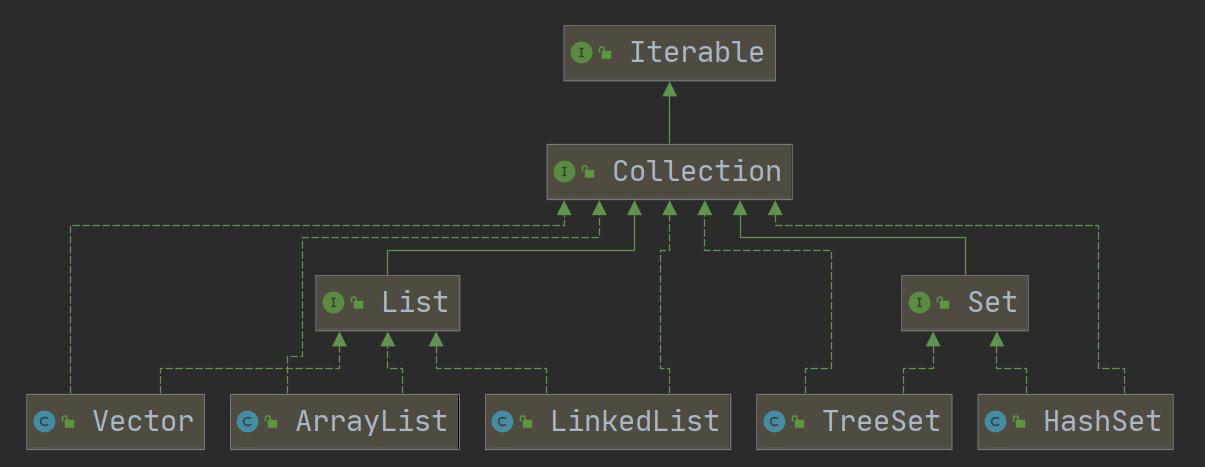

Collection

| 方法名 | 说明 |
|---|---|
| boolean add(E e) | 向集合添加元素e,若指定集合元素改变了则返回true |
| boolean addAll(Collection<? extends E> c) | 把集合C中的元素全部添加到集合中,若指定集合元素改变返回true |
| void clear() | 清空所有集合元素 |
| boolean contains(Object o) | 判断指定集合是否包含对象o |
| boolean containsAll(Collection<?> c) | 判断指定集合是否包含集合c的所有元素 |
| boolean isEmpty() | 判断指定集合的元素size是否为0 |
| boolean remove(Object o) | 删除集合中的元素对象o,若集合有多个o元素,则只会删除第一个元素 |
| boolean removeAll(Collection<?> c) | 删除指定集合包含集合c的元素 |
| boolean retainAll(Collection<?> c) | 从指定集合中保留包含集合c的元素,其他元素则删除 |
| int size() | 集合的元素个数 |
| T[] toArray(T[] a) | 将集合转换为T类型的数组 |
- Iterator(迭代器)
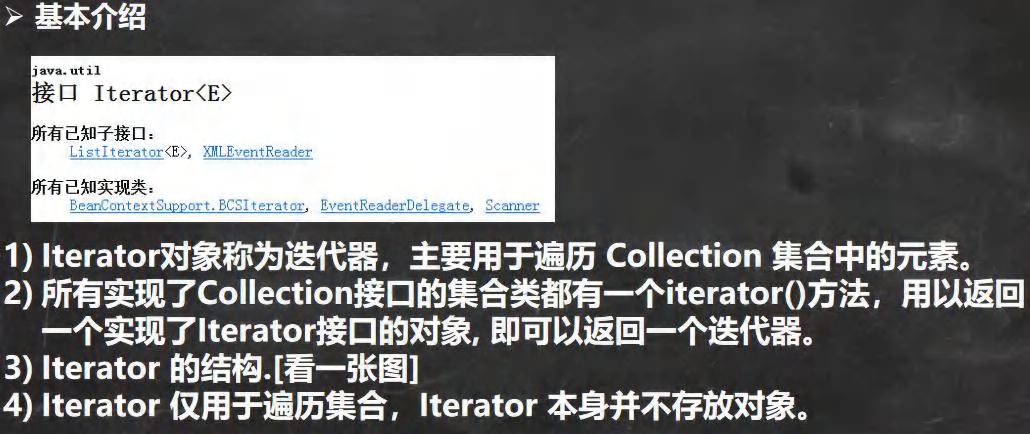
- Collection 接口遍历对象方式2-for 循环增强
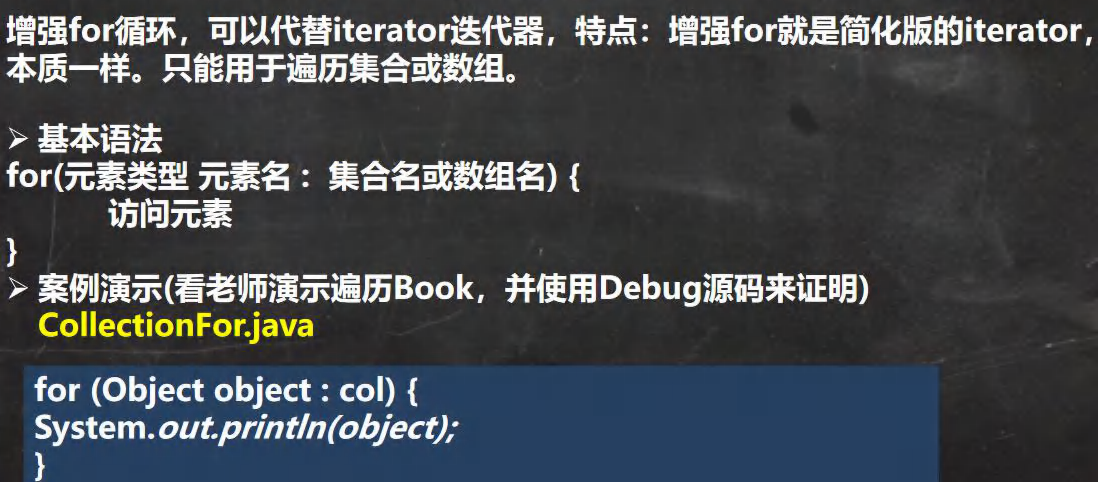
List
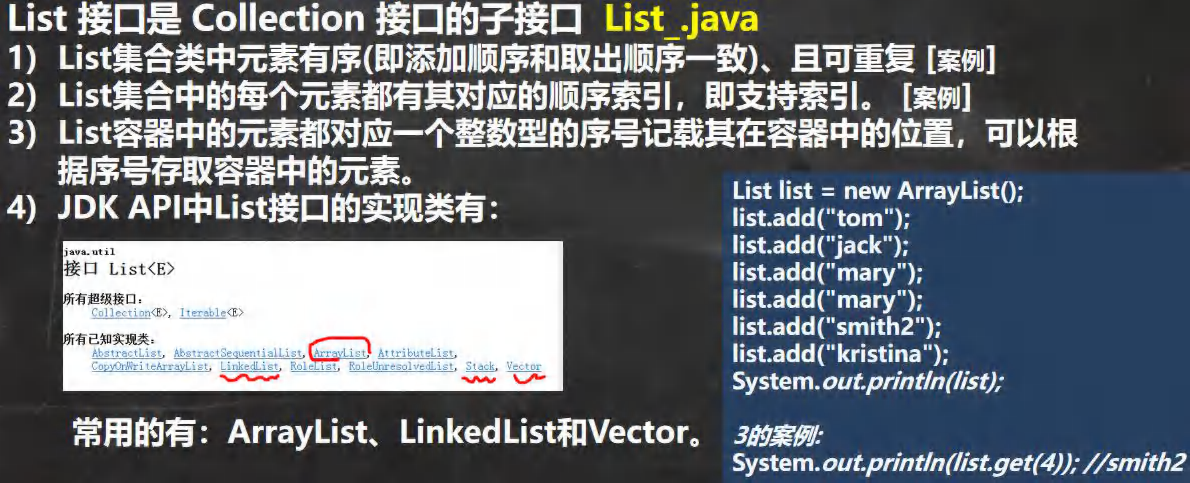
List list = new ArrayList();
list.add("张三丰");
list.add("贾宝玉");
// void add(int index, Object ele):在index 位置插入ele 元素
//在index = 1 的位置插入一个对象
list.add(1, "韩顺平");
System.out.println("list=" + list);
// boolean addAll(int index, Collection eles):从index 位置开始将eles 中的所有元素添加进来
List list2 = new ArrayList();
list2.add("jack");
list2.add("tom");
list.addAll(1, list2);
System.out.println("list=" + list);
// Object get(int index):获取指定index 位置的元素
//说过
// int indexOf(Object obj):返回obj 在集合中首次出现的位置
System.out.println(list.indexOf("tom"));//2
// int lastIndexOf(Object obj):返回obj 在当前集合中末次出现的位置
list.add("韩顺平");
System.out.println("list=" + list);
System.out.println(list.lastIndexOf("韩顺平"));
// Object remove(int index):移除指定index 位置的元素,并返回此元素
list.remove(0);
System.out.println("list=" + list);
// Object set(int index, Object ele):设置指定index 位置的元素为ele , 相当于是替换.
list.set(1, "玛丽");
System.out.println("list=" + list);
// List subList(int fromIndex, int toIndex):返回从fromIndex 到toIndex 位置的子集合
// 注意返回的子集合fromIndex <= subList < toIndex
List returnlist = list.subList(0, 2);
System.out.println("returnlist=" + returnlist);
- List 的三种遍历方式[ArrayList, LinkedList,Vector]

ArrayList

- ArrayList 的底层操作机制源码分析(重点,难点.)

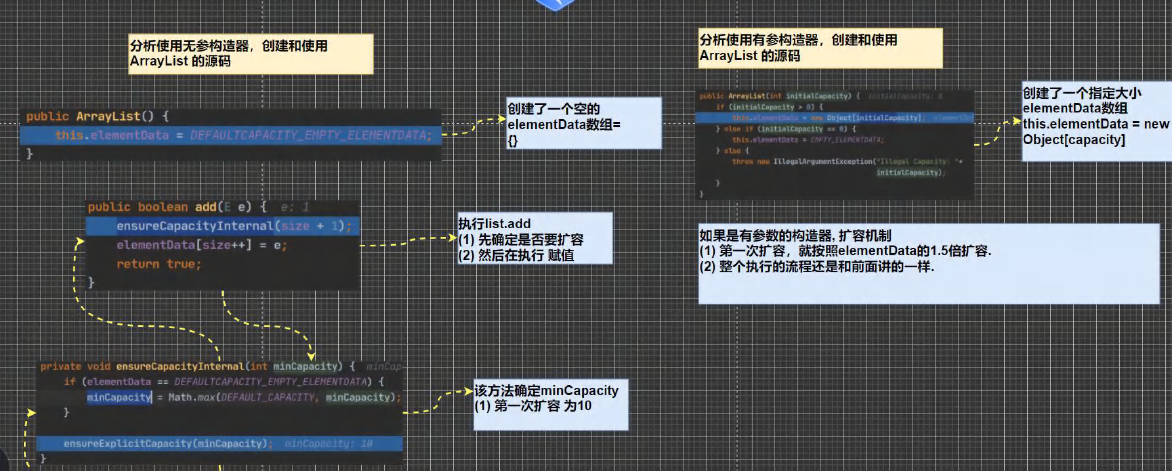
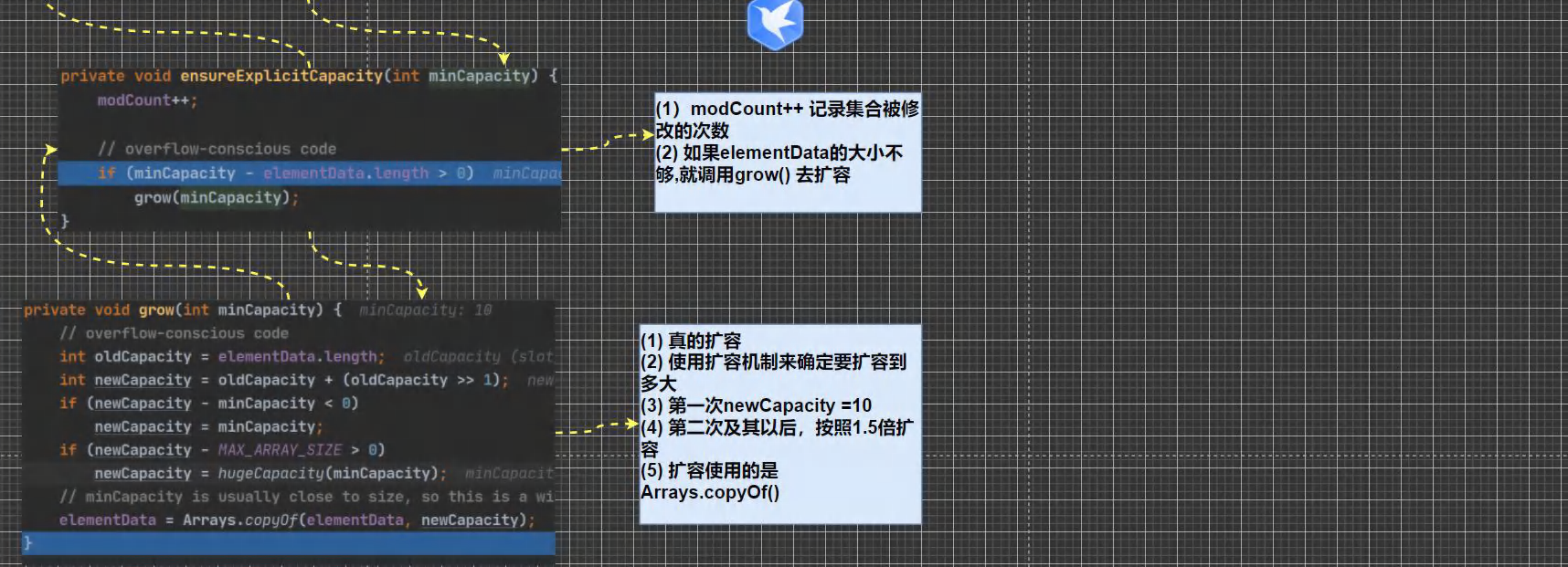
Vector
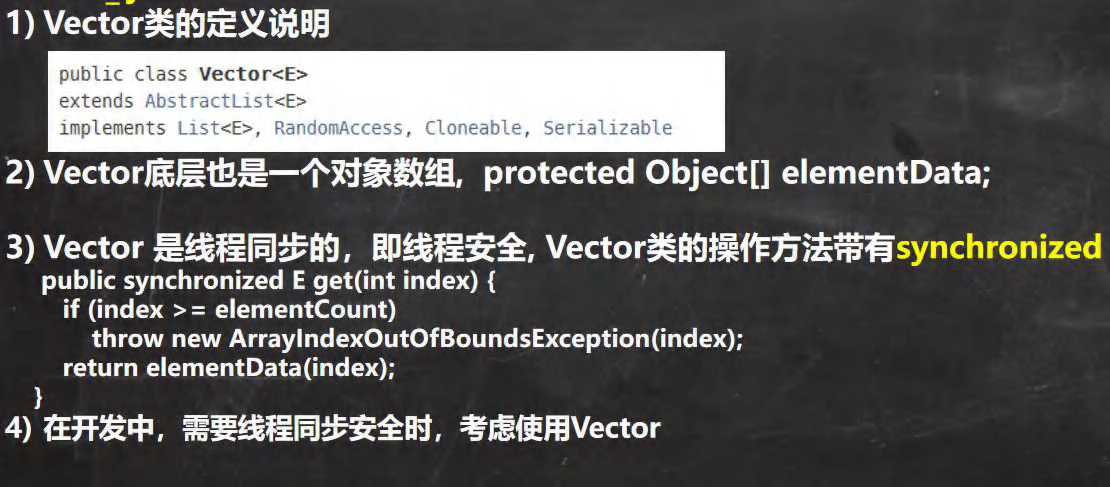
//老韩解读源码
//1. new Vector() 底层
public Vector() {
this(10);
}
补充:如果是Vector vector = new Vector(8);
走的方法:
public Vector(int initialCapacity) {
this(initialCapacity, 0);
}
2. vector.add(i)
2.1 //下面这个方法就添加数据到vector 集合
public synchronized boolean add(E e) {
modCount++;
ensureCapacityHelper(elementCount + 1);
elementData[elementCount++] = e;
return true;
}
2.2 //确定是否需要扩容条件: minCapacity - elementData.length>0
private void ensureCapacityHelper(int minCapacity) {
// overflow-conscious code
if (minCapacity - elementData.length > 0)
grow(minCapacity);
}
2.3 //如果需要的数组大小不够用,就扩容, 扩容的算法
//newCapacity = oldCapacity + ((capacityIncrement > 0) ? capacityIncrement : oldCapacity);
//就是扩容两倍.
private void grow(int minCapacity) {
// overflow-conscious code
int oldCapacity = elementData.length;
int newCapacity = oldCapacity + ((capacityIncrement > 0) ? capacityIncrement : oldCapacity);
if (newCapacity - minCapacity < 0)
newCapacity = minCapacity;
if (newCapacity - MAX_ARRAY_SIZE > 0)
newCapacity = hugeCapacity(minCapacity);
elementData = Arrays.copyOf(elementData, newCapacity);
}
Vector 和ArrayList 的比较
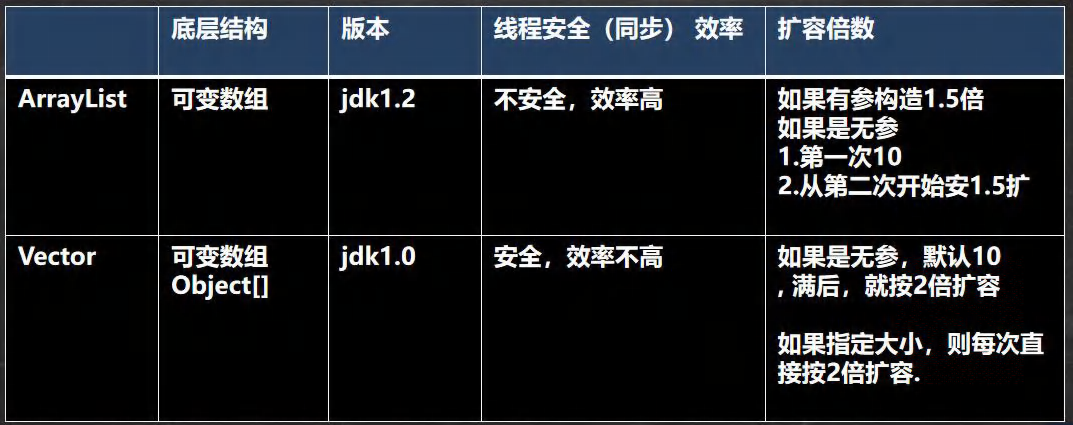
LinkedList

- LinkedList 的底层操作机制
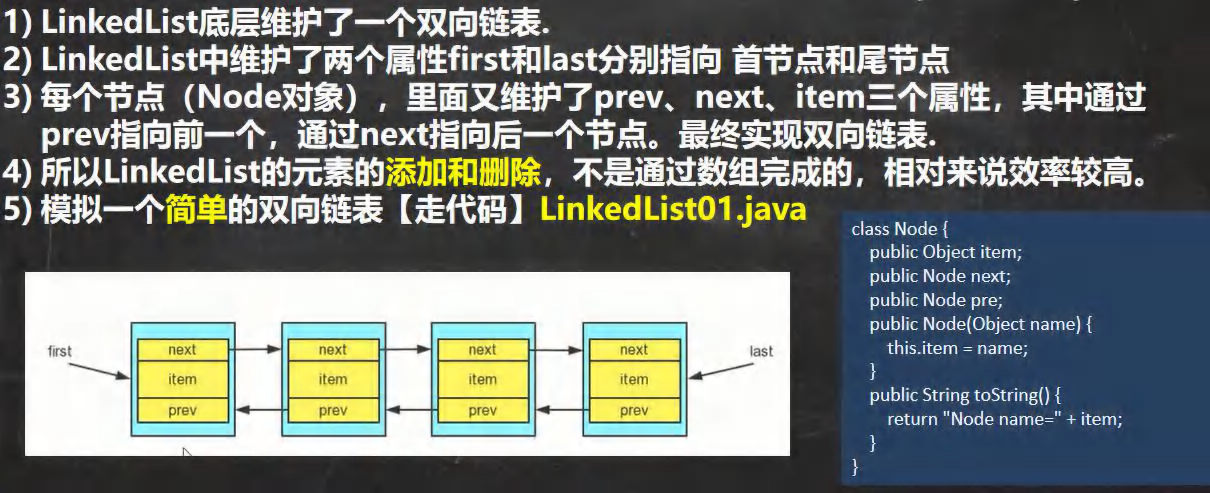
ArrayList 和LinkedList 比较
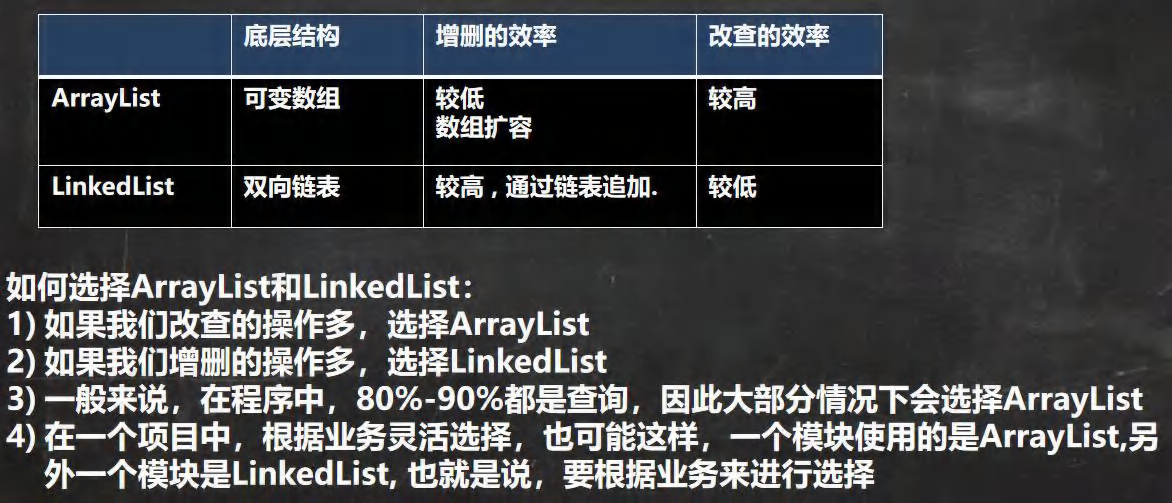
Set
和List 接口一样, Set 接口也是Collection 的子接口,因此,常用方法和Collection 接口一样.

HashSet

- HashSet 底层机制说明

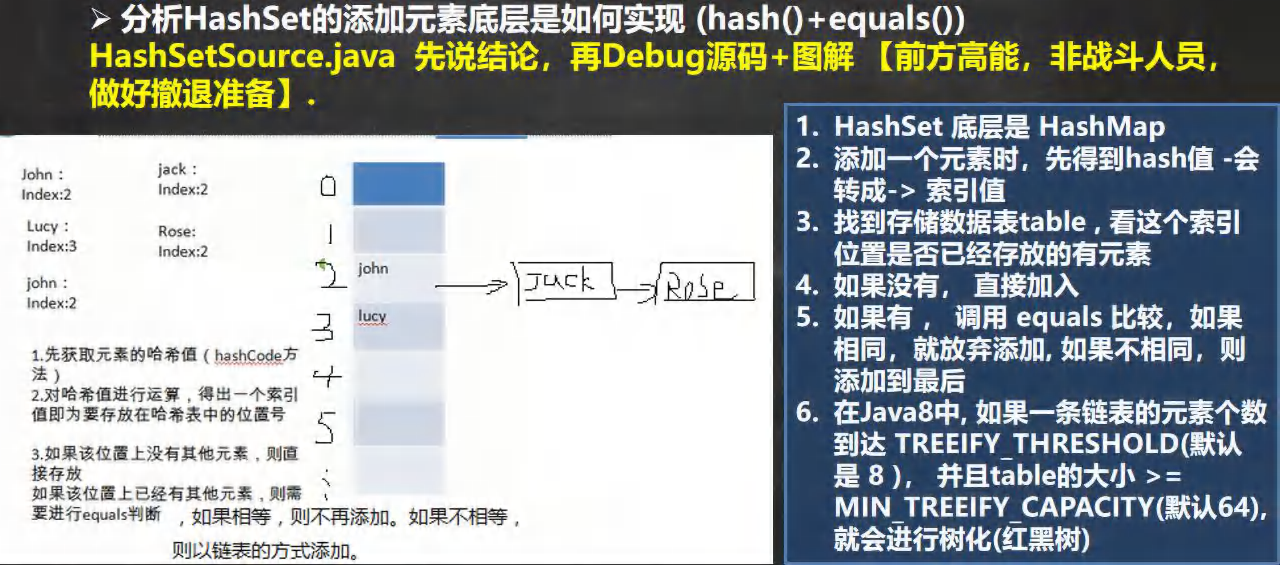
老韩对HashSet 的源码解读
1. 执行HashSet()
public HashSet() {
map = new HashMap<>();
}
2. 执行add()
public boolean add(E e) {//e = "java"
return map.put(e, PRESENT)==null;//(static) PRESENT = new Object();
}
3.执行put() , 该方法会执行hash(key) 得到key 对应的hash 值算法h = key.hashCode()) ^ (h >>> 16)
public V put(K key, V value) {//key = "java" value = PRESENT 共享
return putVal(hash(key), key, value, false, true);
}
4.执行putVal
final V putVal(int hash, K key, V value, boolean onlyIfAbsent,boolean evict) {
Node<K,V>[] tab; Node<K,V> p; int n, i; //定义了辅助变量
//table 就是HashMap 的一个数组,类型是Node[]
//if 语句表示如果当前table 是null, 或者大小=0
//就是第一次扩容,到16 个空间.
if ((tab = table) == null || (n = tab.length) == 0)
n = (tab = resize()).length;
//(1)根据key,得到hash 去计算该key 应该存放到table 表的哪个索引位置
//并把这个位置的对象,赋给p
//(2)判断p 是否为null
//(2.1) 如果p 为null, 表示还没有存放元素, 就创建一个Node (key="java",value=PRESENT)
//(2.2) 就放在该位置tab[i] = newNode(hash, key, value, null)
if ((p = tab[i = (n - 1) & hash]) == null)
tab[i] = newNode(hash, key, value, null);
else {
//一个开发技巧提示: 在需要局部变量(辅助变量)时候,在创建
Node<K,V> e; K k; //
//如果当前索引位置对应的链表的第一个元素和准备添加的key 的hash 值一样
//并且满足下面两个条件之一:
//(1) 准备加入的key 和p 指向的Node 结点的key 是同一个对象
//(2) p 指向的Node 结点的key 的equals() 和准备加入的key 比较后相同
//就不能加入
if (p.hash == hash && ((k = p.key) == key || (key != null && key.equals(k))))
e = p;
//再判断p 是不是一颗红黑树,
//如果是一颗红黑树,就调用putTreeVal , 来进行添加
else if (p instanceof TreeNode)
e = ((TreeNode<K,V>)p).putTreeVal(this, tab, hash, key, value);
else {//如果table 对应索引位置,已经是一个链表, 就使用for 循环比较
//(1) 依次和该链表的每一个元素比较后,都不相同, 则加入到该链表的最后
// 注意在把元素添加到链表后,立即判断该链表是否已经达到8 个结点
// , 就调用treeifyBin() 对当前这个链表进行树化(转成红黑树)
// 注意,在转成红黑树时,要进行判断, 判断条件
// if (tab == null || (n = tab.length) < MIN_TREEIFY_CAPACITY(64))
// resize();
// 如果上面条件成立,先table 扩容.
// 只有上面条件不成立时,才进行转成红黑树
//(2) 依次和该链表的每一个元素比较过程中,如果有相同情况,就直接break
for (int binCount = 0; ; ++binCount) {
if ((e = p.next) == null) {
p.next = newNode(hash, key, value, null);
if (binCount >= TREEIFY_THRESHOLD(8) - 1) // -1 for 1st
treeifyBin(tab, hash);
break;
}
if (e.hash == hash &&((k = e.key) == key || (key != null && key.equals(k))))
break;
p = e;
}
}
if (e != null) { // existing mapping for key
V oldValue = e.value;
if (!onlyIfAbsent || oldValue == null)
e.value = value;
afterNodeAccess(e);
return oldValue;
}
}
++modCount;
//size 就是我们每加入一个结点Node(k,v,h,next), size++
if (++size > threshold)
resize();//扩容
afterNodeInsertion(evict);
return null;
}

LinkedHashSet
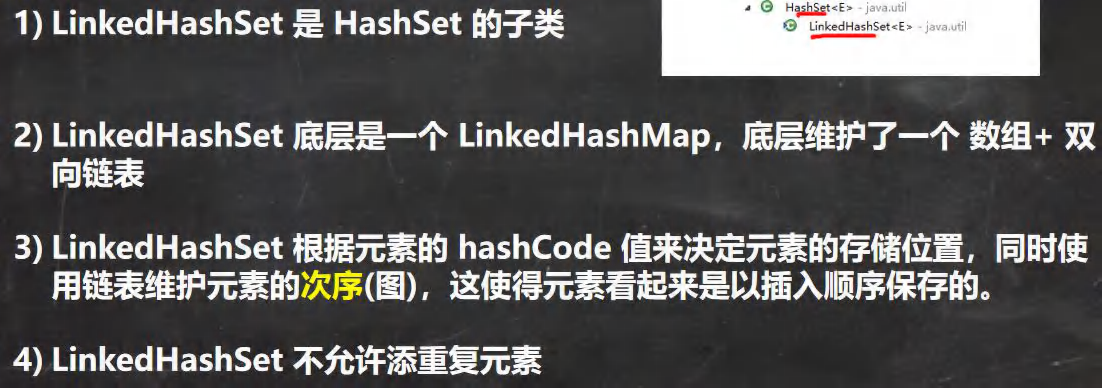

Map
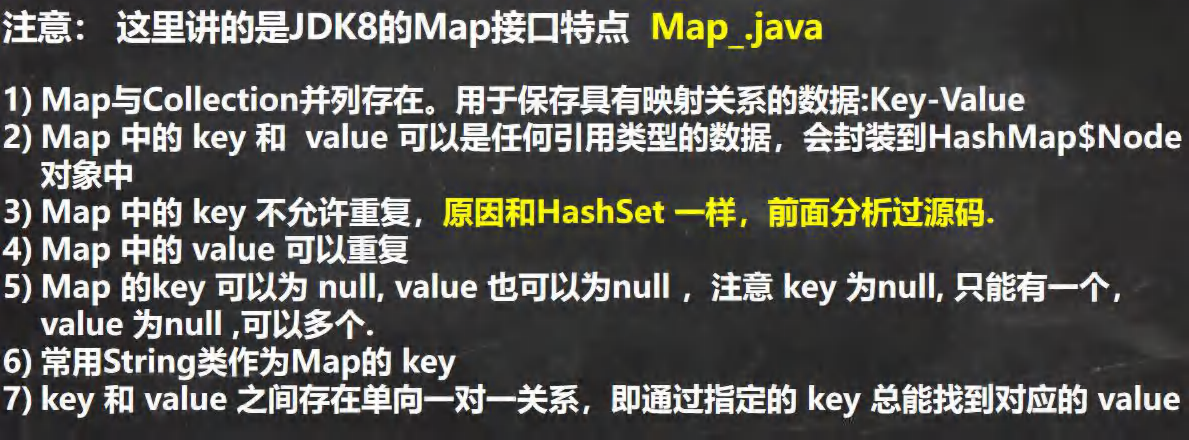
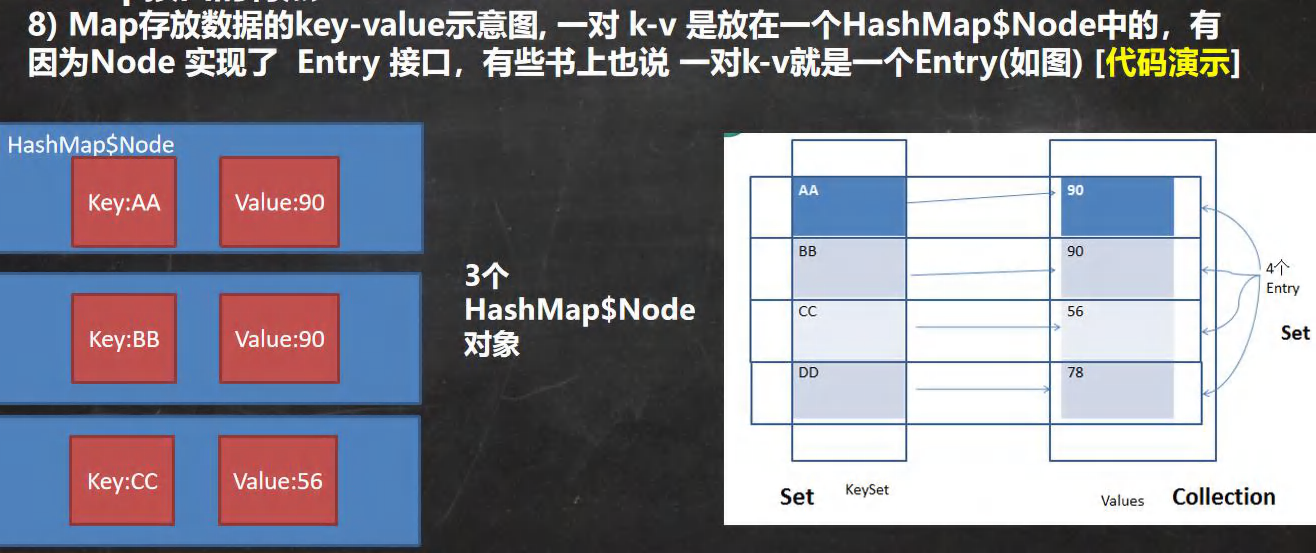
- Map 接口遍历方法
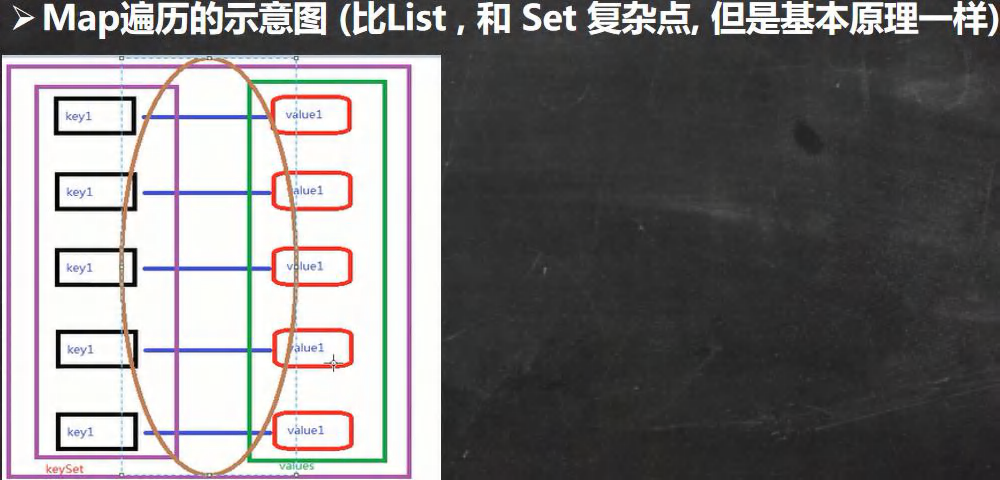
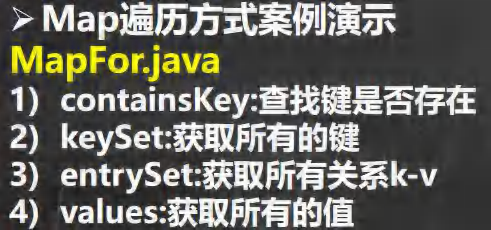
//第一组: 先取出所有的Key , 通过Key 取出对应的Value
Set keyset = map.keySet();
//(1) 增强for
System.out.println("-----第一种方式-------");
for (Object key : keyset) {
System.out.println(key + "-" + map.get(key));
}
//(2) 迭代器
System.out.println("----第二种方式--------");
Iterator iterator = keyset.iterator();
while (iterator.hasNext()) {
Object key = iterator.next();
System.out.println(key + "-" + map.get(key));
}
//第二组: 把所有的values 取出
Collection values = map.values();
//这里可以使用所有的Collections 使用的遍历方法
//(1) 增强for
System.out.println("---取出所有的value 增强for----");
for (Object value : values) {
System.out.println(value);
}
//(2) 迭代器
System.out.println("---取出所有的value 迭代器----");
Iterator iterator2 = values.iterator();
while (iterator2.hasNext()) {
Object value = iterator2.next();
System.out.println(value);
}
//第三组: 通过EntrySet 来获取k-v
Set entrySet = map.entrySet();// EntrySet<Map.Entry<K,V>>
//(1) 增强for
System.out.println("----使用EntrySet 的for 增强(第3 种)----");
for (Object entry : entrySet) {
//将entry 转成Map.Entry
Map.Entry m = (Map.Entry) entry;
System.out.println(m.getKey() + "-" + m.getValue());
}
//(2) 迭代器
System.out.println("----使用EntrySet 的迭代器(第4 种)----");
Iterator iterator3 = entrySet.iterator();
while (iterator3.hasNext()) {
Object entry = iterator3.next();
//System.out.println(next.getClass());//HashMap$Node -实现-> Map.Entry (getKey,getValue)
//向下转型Map.Entry
Map.Entry m = (Map.Entry) entry;
System.out.println(m.getKey() + "-" + m.getValue());
}
HashMap

- 底层机制及源码剖析
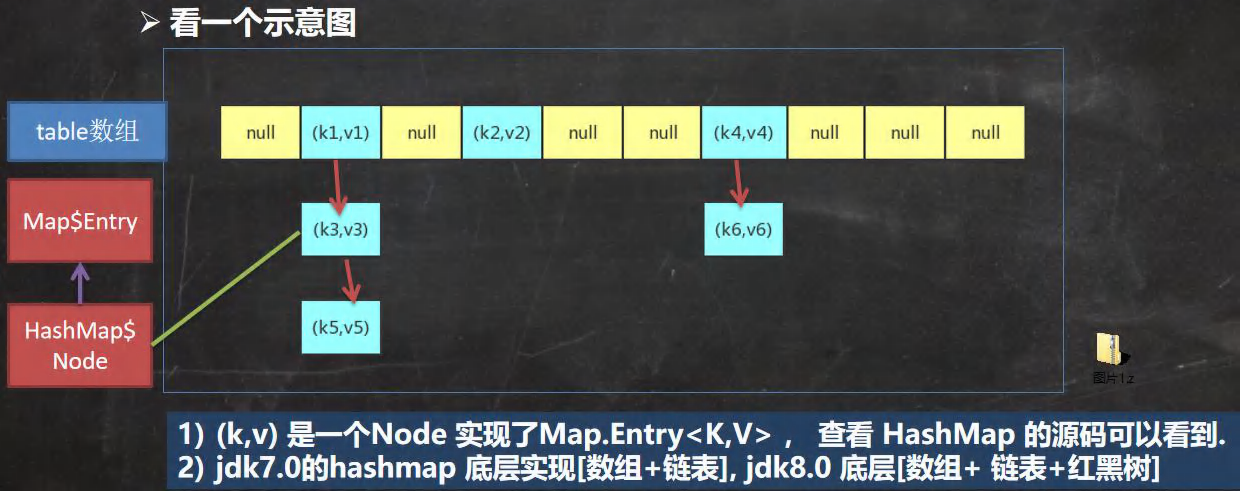
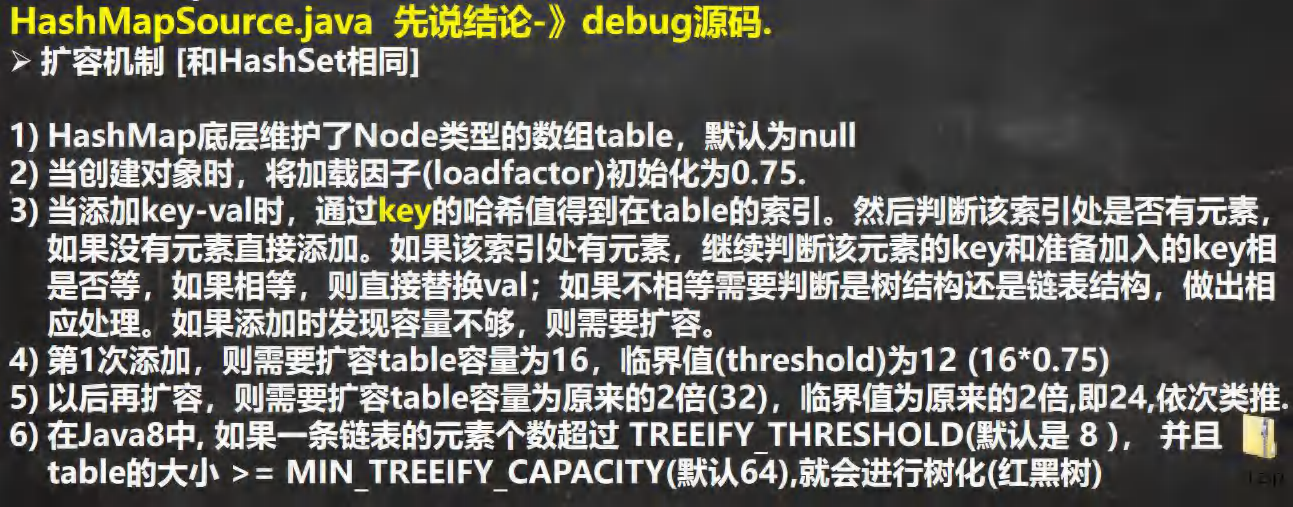
1.执行构造器new HashMap()
初始化加载因子loadfactor = 0.75
HashMap$Node[] table = null
2. 执行put 调用hash 方法,计算key 的hash 值(h = key.hashCode()) ^ (h >>> 16)
public V put(K key, V value) {
//K = "java" value = 10
return putVal(hash(key), key, value, false, true);
}
3. 执行putVal
final V putVal(int hash, K key, V value, boolean onlyIfAbsent, boolean evict) {
Node<K,V>[] tab;
Node<K,V> p;
int n, i;//辅助变量
//如果底层的table 数组为null, 或者length =0 , 就扩容到16
if ((tab = table) == null || (n = tab.length) == 0)
n = (tab = resize()).length;
//取出hash 值对应的table 的索引位置的Node, 如果为null, 就直接把加入的k-v
//, 创建成一个Node ,加入该位置即可
if ((p = tab[i = (n - 1) & hash]) == null)
tab[i] = newNode(hash, key, value, null);
else {
Node<K,V> e; K k;//辅助变量
// 如果table 的索引位置的key 的hash 相同和新的key 的hash 值相同,
// 并满足(table 现有的结点的key 和准备添加的key 是同一个对象|| equals 返回真)
// 就认为不能加入新的k-v
if (p.hash == hash &&
((k = p.key) == key || (key != null && key.equals(k))))
e = p;
else if (p instanceof TreeNode)//如果当前的table 的已有的Node 是红黑树,就按照红黑树的方式处
理
e = ((TreeNode<K,V>)p).putTreeVal(this, tab, hash, key, value);
else {
//如果找到的结点,后面是链表,就循环比较
for (int binCount = 0; ; ++binCount) {//死循环
if ((e = p.next) == null) {//如果整个链表,没有和他相同,就加到该链表的最后
p.next = newNode(hash, key, value, null);
//加入后,判断当前链表的个数,是否已经到8 个,到8 个,后
//就调用treeifyBin 方法进行红黑树的转换
if (binCount >= TREEIFY_THRESHOLD - 1) // -1 for 1st
treeifyBin(tab, hash);
break;
}
if (e.hash == hash && //如果在循环比较过程中,发现有相同,就break,就只是替换value
((k = e.key) == key || (key != null && key.equals(k))))
break;
p = e;
}
}
if (e != null) { // existing mapping for key
V oldValue = e.value;
if (!onlyIfAbsent || oldValue == null)
e.value = value; //替换,key 对应value
afterNodeAccess(e);
return oldValue;
}
}
++modCount;//每增加一个Node ,就size++
if (++size > threshold[12-24-48])//如size > 临界值,就扩容
resize();
afterNodeInsertion(evict);
return null;
}
5. 关于树化(转成红黑树)
//如果table 为null ,或者大小还没有到64,暂时不树化,而是进行扩容.
//否则才会真正的树化-> 剪枝
final void treeifyBin(Node<K,V>[] tab, int hash) {
int n, index; Node<K,V> e;
if (tab == null || (n = tab.length) < MIN_TREEIFY_CAPACITY)
resize();
}
Hashtable
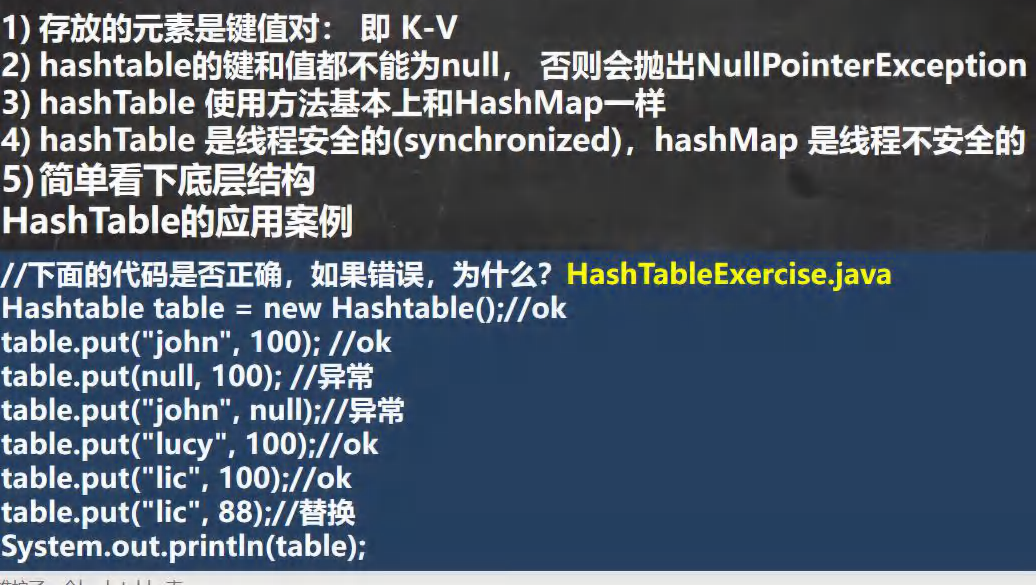
Hashtable 和HashMap 对比

Properties

总结-开发中如何选择集合实现类
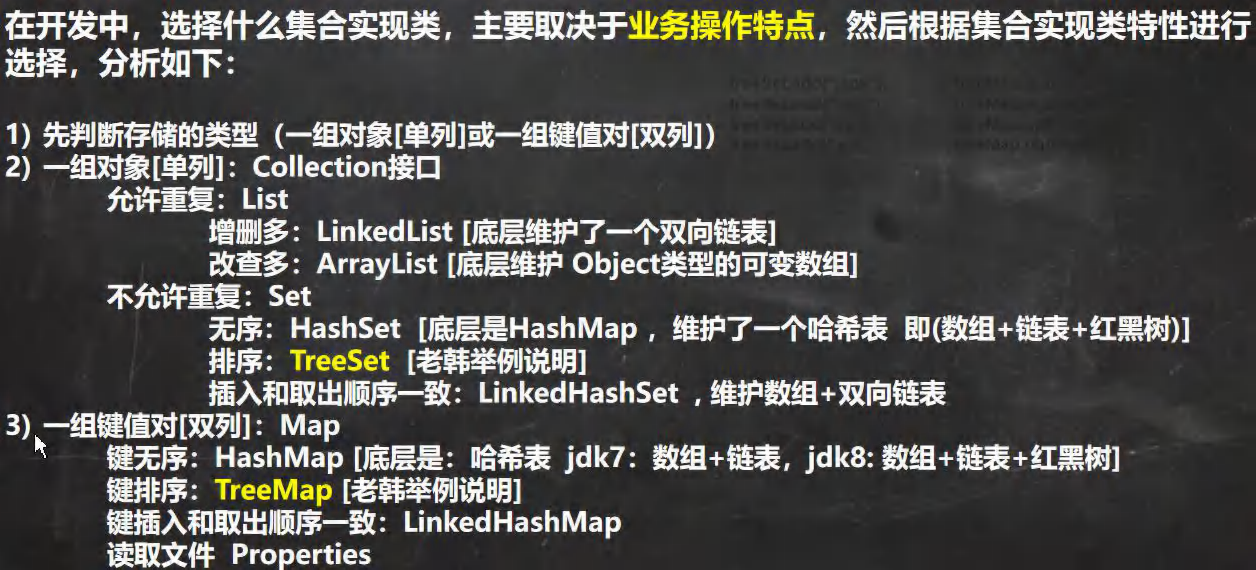
Collections 工具类

- 排序操作:(均为static 方法)

- 查找、替换
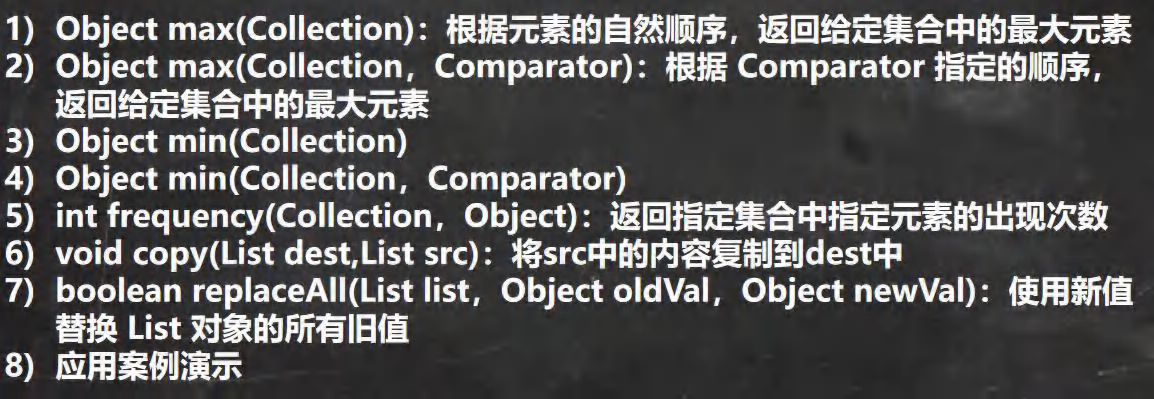






















 343
343











 被折叠的 条评论
为什么被折叠?
被折叠的 条评论
为什么被折叠?








